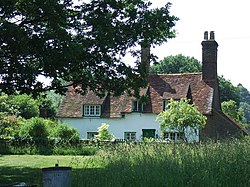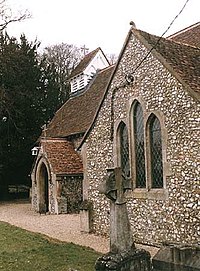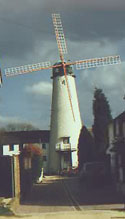Cholesbury: Difference between revisions
Created page with "{{Infobox town |name=Cholesbury |county=Buckinghamshire |picture=Cholesbury - Cottage - geograph.org.uk - 188688.jpg |picture caption=A cottage on the Green in Cholesbury |os..." |
|||
| Line 31: | Line 31: | ||
The earliest trace of occupation in the village has been a Palaeolithic hand axe found in the 1960s.<ref>Hay and Hay – Hilltop Villages of the Chilterns Chap 1–2</ref> A Bronze Age axe has alsobeen found nearby. | The earliest trace of occupation in the village has been a Palaeolithic hand axe found in the 1960s.<ref>Hay and Hay – Hilltop Villages of the Chilterns Chap 1–2</ref> A Bronze Age axe has alsobeen found nearby. | ||
Cholesbury Camp, a hill fort, is found in the woods in the village. It is believed, from investigations<ref>Kimball, 1933</ref>.to have been constructed between 300 and 100BC, possibly on the site of an earlier settlement eveidenced by the Bronze axe. | |||
The village itself is of a much later age. Its name is recorded as '''Chelwardisbyry''' in the 13th century, but it is of much earlier origin, from the Old English ''Cealwealdes burg''; 'Cealwald's fort', believed to refer to Cholesbury Camp. | The village itself is of a much later age. Its name is recorded as '''Chelwardisbyry''' in the 13th century, but it is of much earlier origin, from the Old English ''Cealwealdes burg''; 'Cealwald's fort', believed to refer to Cholesbury Camp. | ||
Latest revision as of 13:12, 24 August 2018
| Cholesbury | |
| Buckinghamshire | |
|---|---|
 A cottage on the Green in Cholesbury | |
| Location | |
| Grid reference: | SP930070 |
| Location: | 51°45’17"N, -0°39’8"W |
| Data | |
| Post town: | Tring |
| Postcode: | HP23 |
| Dialling code: | 01494 |
| Local Government | |
| Council: | Buckinghamshire |
| Parliamentary constituency: |
Chesham and Amersham |
| Website: | www.cholesbury.com |
Cholesbury is a village in Buckinghamshire, on the border with Hertfordshire. It is set around an extensive village common, and all within the Chiltern woodlands. Close by the village is an Iron Age hill fort, Cholesbury Camp, with extensive, high earthen ramparts stark today notwithstanding being long colonised by the woods.
The village is nestles in the fine walking country of the Chiltern Hills, about four miles east of Wendover, five miles north of Chesham and five miles too from Berkhamsted.
Geography

Cholesbury is located within Chiltern downland landscape on the upland plateau and close to the chalk escarpment which overlooks the Aylesbury Vale. At its highest point the village is some 650 feet above sea level.
Villages in this part of the Chilterns are often set out around Greens and Commons or strung out along ridges with which they connect often without a gap to adjacent settlements. Cholesbury is consequently more closely linked in this way with the neighbouring villages of Hawridge, St Leonards and Buckland Common. The hamlet of Braziers End is closely associated with the village of Cholesbury. The name is purported to derive from braziers lit by Gypsies who periodically gathered to celebrate weddings.
Historically, many homes had access to orchards, gardens for vegetable production and pasture for domestic animals. These have largely disappeared and over the last ten years or so the increasing popularity of horse riding has created a demand for suitable land for paddocks.[1]
History
Foundation to the Middle Ages
The earliest trace of occupation in the village has been a Palaeolithic hand axe found in the 1960s.[2] A Bronze Age axe has alsobeen found nearby.
Cholesbury Camp, a hill fort, is found in the woods in the village. It is believed, from investigations[3].to have been constructed between 300 and 100BC, possibly on the site of an earlier settlement eveidenced by the Bronze axe.
The village itself is of a much later age. Its name is recorded as Chelwardisbyry in the 13th century, but it is of much earlier origin, from the Old English Cealwealdes burg; 'Cealwald's fort', believed to refer to Cholesbury Camp.

The Domesday Book of 1086 records that in the days of Edward the Confessor the land was part of the estate of Aluric, the King’s thane. Chowdesbury was then part of the manor of Draiton valued at 100 shillings (£5). Magno le Breton who held the manor under a tenancy to one Helgist would have valued the hilltop area for its summer pasture supported by reliable springs feeding ponds. From the record of land use the area was still heavily wooded being able to sustain 200 hogs.[4]
In 1091 the le Breton family granted the income of the estate to the Knights Templar, who held it until the order's dissolution in 1312, when it passed to the Knights Hospitaller, as part of the 'Commandery' of Hogshaw.[5]
In the 12th-century the parish church, St Laurence, was built within the ramparts of the hill-fort.[4] By the reign of King Henry III around 1248 Cholesbury hasd become a separate manor, owned by the le Bretons. The church was enlarged with the adding of a porch and its importance recognised with the appointment of a resident parson by the name of Abel. In 1336 Mary the Dowager Countess of Norfolk acquired the manor, along with Drayton Beauchamp. The family later granted the estate to King Edward II but in 1364 it was passed to Thomas Cheyne.
Modern Age
In 1541 Robert Cheyne sold the manor to John Baldwin, the Lord Chief Justice.[4] In 1618, John Baldwin sold the manor to one Thomas Stile, one of the attorneys of the Court of King's Bench. By 1650 the rights attaching to the Lord of the Manor were transferred to the Seare family who also held the manor in neighbouring Hawridge.
Until the middle of the 18th century, Cholesbury was a chapelry of the parish of Drayton Beauchamp. In 1756 though, the Parish of Cholesbury was established by the Diocese of Lincoln.[6]

The sparse income from the unfertile Chilterns lands ensured that from 1812 onwards the parish vestry was unable to raise sufficient funds to support the poor and in 1832 declared itself bankrupt. An account of the plight of the parish was recorded in the report to Parliament by the Poor Law Commission provided by the Rev. Henry Jeston, vicar since 1830. Between 1832 and 1835 Jeston raised sufficient loans from neighbouring parishes and advances from landowners, including himself, to rescue the parish from its plight and put into effect measures to ensure the future financial security of the parish.[7] He was mentioned in the subsequent debate which led to reform of the Poor Laws for which Herbert Spencer provided an account in his most famous book The Man Versus the State.[8] The village recognised Jeston's achievements through raising a subscription for a stained-glassed window in his honour.
Until 1935 Cholesbury did not have mains water and drainage did not arrive until 1963. The road down to Chesham was frequently impassable in winter and periodic flooding has occurred even in recent years. The Second World War resulted in an influx of people escaping the London Blitz and not returning afterwards. This migration had a lasting effect with more houses built or greatly enlarged or refurbished. Transport improvements enabling daily commuting to London from the 1950s onwards also led to a further change with the growth in more affluent families which irrevocably changed the composition of the village community.
About the village

Cholesbury Common runs through the village either side of the road.
The Manor House dates back to the end of the 16th century and was once considerably larger than it is today. Many of the older houses in the village also date from around this time of expansion.
Cholesbury Camp an Iron Age hillfort and scheduled monument, is the dominant feature in the landscape. It almost circular in shape and the 25-acre site is enclosed by a double rampart or 'vallum', broken on its southern side by houses. Originally a wooden palisade would have topped the earthworks. Today, the extent of the fort is demarcated by a magnificent stand of mature beech trees.
Associated with the fort is a pond, known locally as the 'Holy’ or ‘Bury’ pond, which is fed by a spring, that is perpetual: it has never been known to run dry, even in the severest of droughts. The church of St Lawrence is within the hillfort's boundary.
Cholesbury Windmill was first built in 1863 as a smock mill but was rebuilt in the style of a tower mill in 1883.
Cholesbury Village Hall, built in 1895 on land given by Frederick Butcher, a banker, from Tring and contemporary of the other banking dynasty, the Rothschild family who also lived in the area. Butcher was a staunch supporter of the Temperance movement and saw the importance of providing recreational facilities for working men as an alternative to the alehouses.
The 'Full Moon' public house dates from the 17th century. The pub was known as the Half Moon until 1812, the Moon from then until 1883, when it took its present name. The Full Moon was the traditional meeting place for the Lord of the Manor of Hawridge to hold court, with proceedings mainly concerned with the use of the commons, especially grazing rights and enclosures.
A stone obelisk on the boundary between Hawridge and Cholesbury was erected in 1898 to mark Queen Victoria's Diamond Jubilee the year before. Nearby a group of three puddingstones was assembled and dedicated in November 2012 on the occasion of the Diamond Jubilee of Queen Elizabeth II.
Sport and recreation
- Cricket: Hawridge and Cholesbury Cricket Club, founded in 1885 with permission from the Lord of the Manor to use the Common.[9]
The local area with its open views, rural lanes, commons and woodland, criss-crossed by footpaths and bridleways consequently are very popular with cyclists, walkers and horse riders.[10]
Events
The churches of Hawridge and Cholesbury jointly hold a summer fête on the August Bank Holiday Monday, alternatively on Hawridge and Cholesbury Commons.
The Vale of Aylesbury with Garth & South Berks Hunt traditionally hold a meet on Boxing Day (26 December) which draws a large crowd from the local district.
The Village Hall hosts events from the organisations, of the local villages (Horticultural Society, Local History Group, Commons Preservation Society, Thursday Club) as well as 'Cholesbury Teas' on Sundays during summer months.[11]
Outside links
| ("Wikimedia Commons" has material about Cholesbury) |
References
- ↑ Hepple & Doggett The Chilterns
- ↑ Hay and Hay – Hilltop Villages of the Chilterns Chap 1–2
- ↑ Kimball, 1933
- ↑ 4.0 4.1 4.2 Records of Buckinghamshire Vol1. 1858
- ↑ House of Knights Hospitallers: The commandery of Hogshaw - British History Online; from A History of the County of Buckingham - Volume 1 : {{{2}}} (Victoria County History)
- ↑ Cholesbury Parish History
- ↑ Records of Buckinghamshire 1961 Volume 17, Part 1 The Vestry at Cholesbury 1829-1894 Arnold Baines, Retrieved 8 June 2013
- ↑ Spencer, Herbert: 'The Coming of Slavery' - Essay 2: 'The Man Versus the State' (1884)
- ↑ Hawridge and Cholesbury Cricket Club
- ↑ Cholesbury-cum-St Leonards – Walks
- ↑ Cholesbury-cum-St Leonards Website – What's on Retrieved 15 June 2009
- Branigan, Keith. (1967). "The distribution and development of Romano-British occupation in the Chess Valley". Records of Buckinghamshire 18: 136–49.
- East, Ray; Fletcher, Keith; Hawkes, Peter (2006). Pubs of Chesham and Villages. England: Hawkes Books. ISBN 0-9554707-0-6.
- Farr, Diana (1978). Gilbert Cannan A Georgian Prodigy. London: Chatto & Windus. ISBN 0-7011-2245-5.
- Gover, J (2001). A Geophysical Survey of Cholesbury Camp Report Unpubl.
- Fletcher, Keith (2005). Chesham's Bricks – A Brief History of Brickmaking in the Chesham Area.
- Hay, David and Joan (1994). Hilltop Villages of the Chilterns. England: Phillimore & Co Ltd. ISBN 0-85033-505-1.
- Hepple & Doggett, Leslie & Alison (1971). The Chilterns. England: Phillimore & Co Ltd. ISBN 0-85033-833-6.
- Kimball, G. D. (1933). "Cholesbury Camp". J. Brit. Arch. Assn. 39 (1): 187–212.
